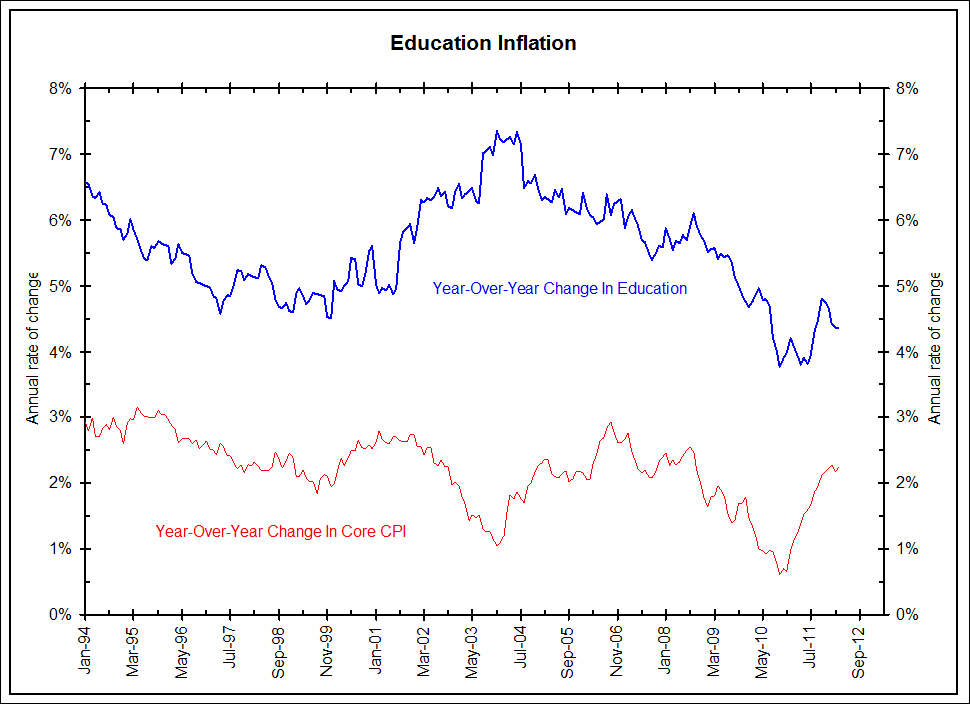Bloomberg.com – Consumer Credit in U.S. Increases by Most in 10 Years
Consumer borrowing in the U.S. surged in March by the most in more than a decade on growing demand for educational financing and autos. Credit rose by $21.4 billion, the biggest gain since November 2001, to $2.54 trillion, Federal Reserve figures showed today in Washington. The advance was paced by a $16.2 billion jump in non-revolving debt, including student and car loans. Americans may have been trying to get school financing before a possible increase in interest rates takes place on July 1. Rising consumer confidence also means that households are more willing to take on debt to boost spending, which accounts for about 70 percent of the economy.
Comment
The story above, like most stories on consumer credit, does not seem to understand the effect that student loans are having on consumer credit.
The chart below shows government-owned consumer credit (red line) and student loans (blue line) are one and the same. You only see one line below because these two series are virtually identical as all student loans are bought by the government and the government currently owns virtually no other type of consumer credit.
Click to enlarge:
As shown above, student loans have gone parabolic thanks to a 2009 government mandated cut in student loan interest rates that expire July 1st.
How important are student loans to overall consumer credit growth? The next chart below shows total consumer credit in the top panel (the series that gets reported and analyzed), student loans in the middle panel (same series as in the chart above) and consumer credit less student loans in the bottom panel.
Take out government-owned student loans and there has been virtually no rebound in consumer credit since the Great Recession ended. Restated, the consumer has not been borrowing since the Great Recession has ended. Rather, students took advantage of below-market rates on loans provided by the government starting in 2009.
What happens to these student loans next? From the story above:
The rate on student loans is set to double on July 1 without action by Congress. The rate increase would affect about 7.4 million students, according to the White House, adding an average of $1,000 a year in payments on college loans.
President Barack Obama last week sought to keep pressure on Congress to freeze the interest rate on federally subsidized student loans, saying a higher education can’t be an unaffordable luxury for middle-income Americans.
Some economists were concerned the jump in educational lending reflected a poor job market.
“Most of the improvement in credit is a function of the explosion student loan debt,” said Neil Dutta, an economist at Bank of America Corp. in New York. “The reason student loan debt is exploding? Because the youth population is having difficulty finding work. Hardly a good reason for credit extension.”
Final Note
The government has always subsidized education, a noble goal that has consequences.
Whenever anything gets subsidized, demand increases. And without an increase on supply to offset it, the price rises. As the chart below shows, the price of education has been significantly outpacing core inflation. This is the consequence of below-market loans.
Huffington Post – The Most Expensive Colleges In America
Sarah Lawrence College: $59,170
New York University: $56,787
Columbia University: $56,310
Harvey Mudd College: $55,998
Eugene Lang College: $55,890
Claremont McKenna College: $55,865
Wesleyan University: $55,706
Bard College: $55,617
Barnard College: $55,566
Trinity College: $55,450
Source: Bianco Research





What's been said:
Discussions found on the web: